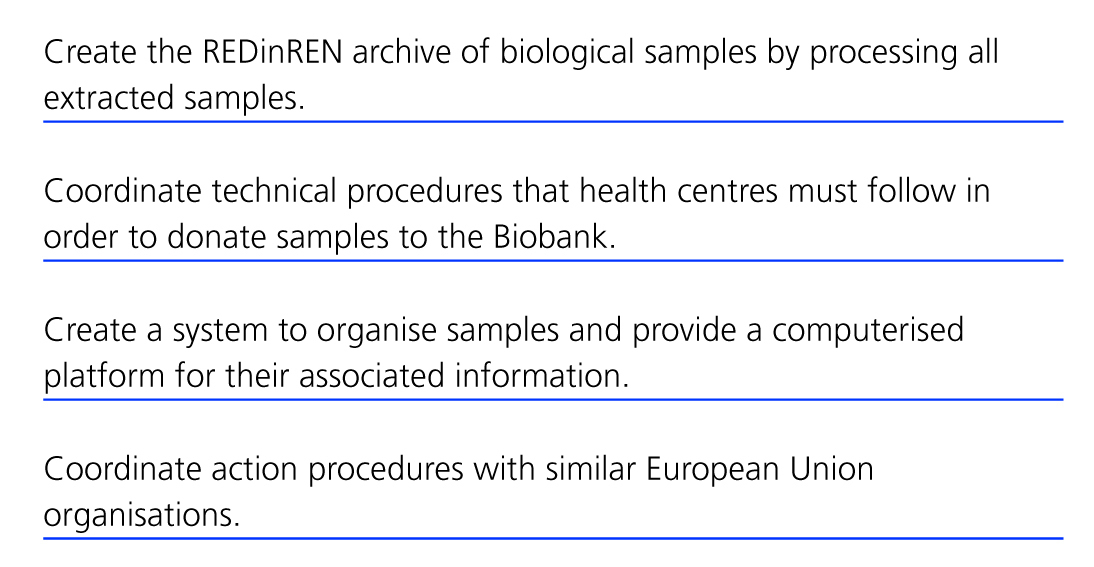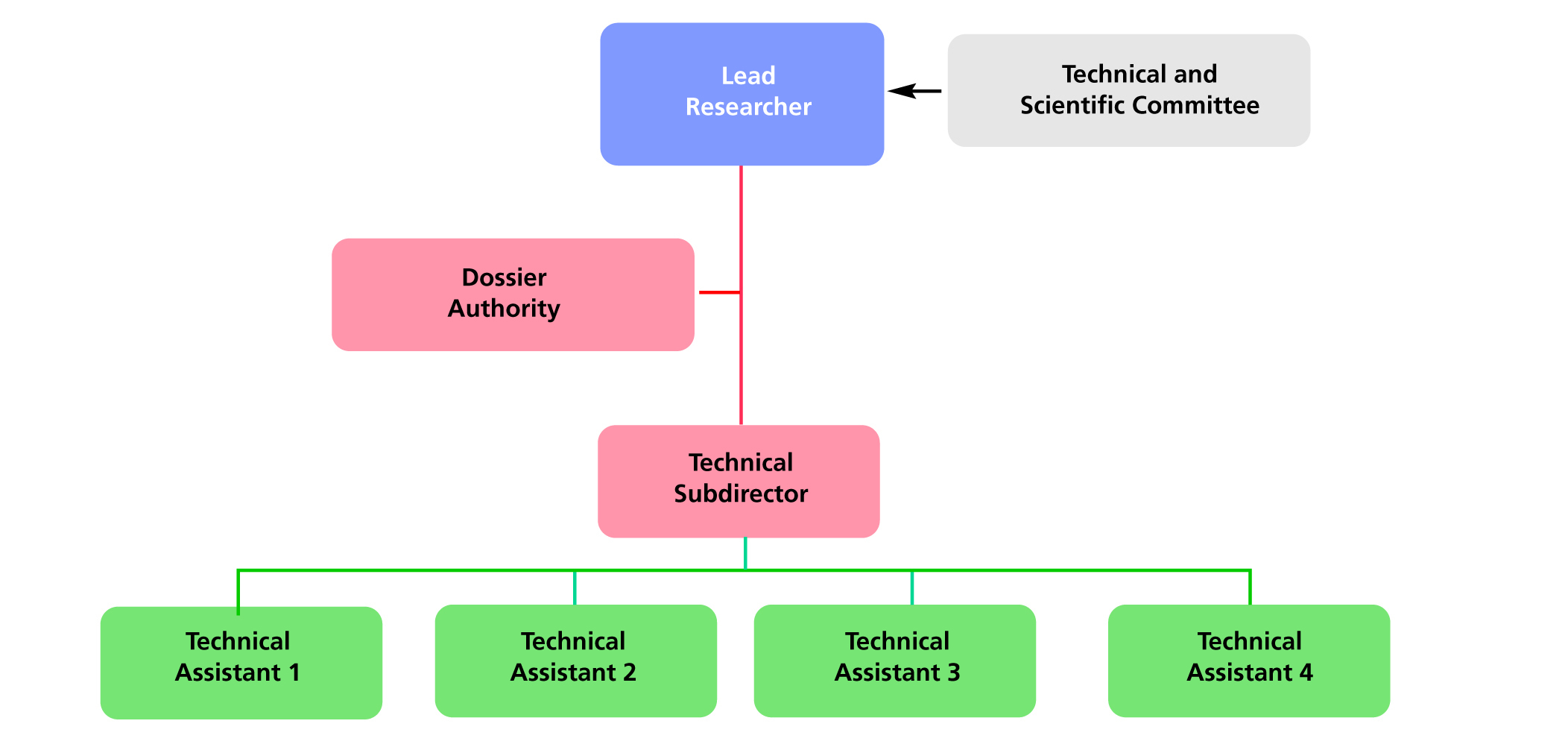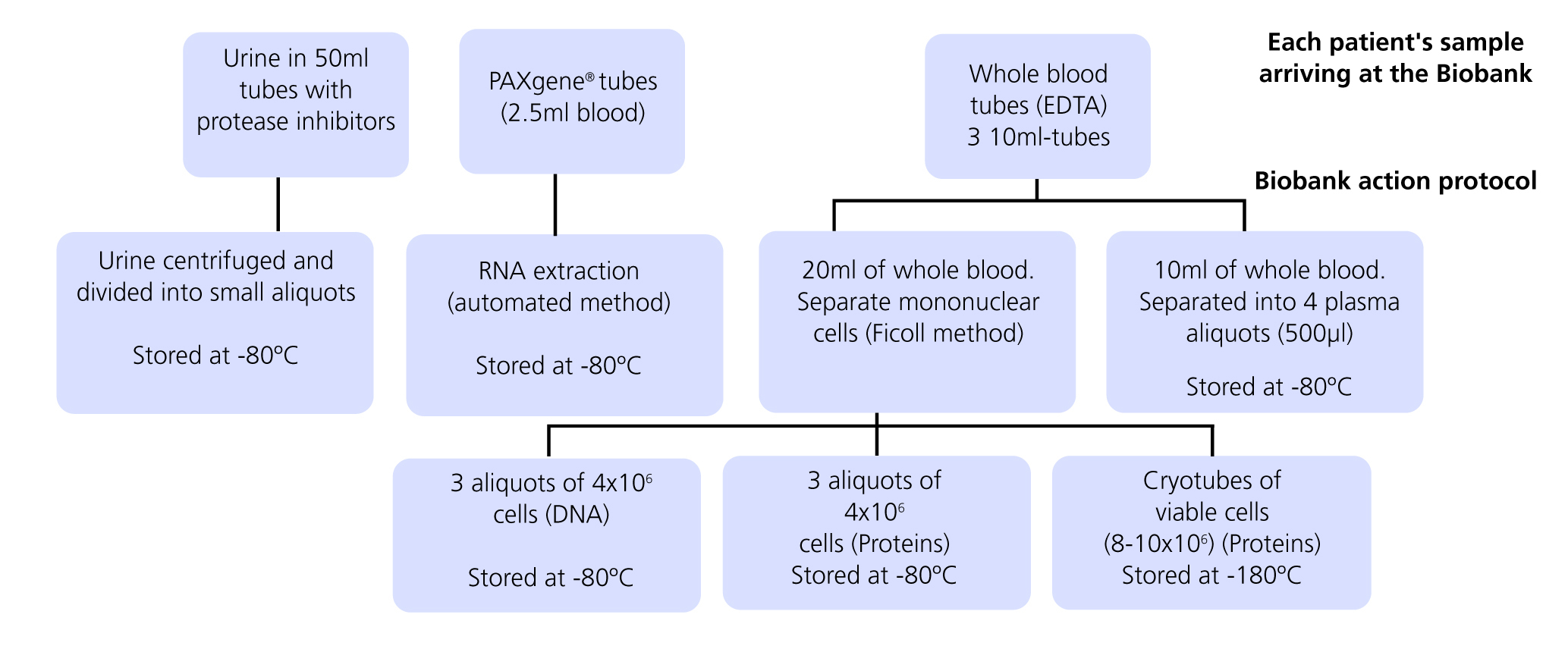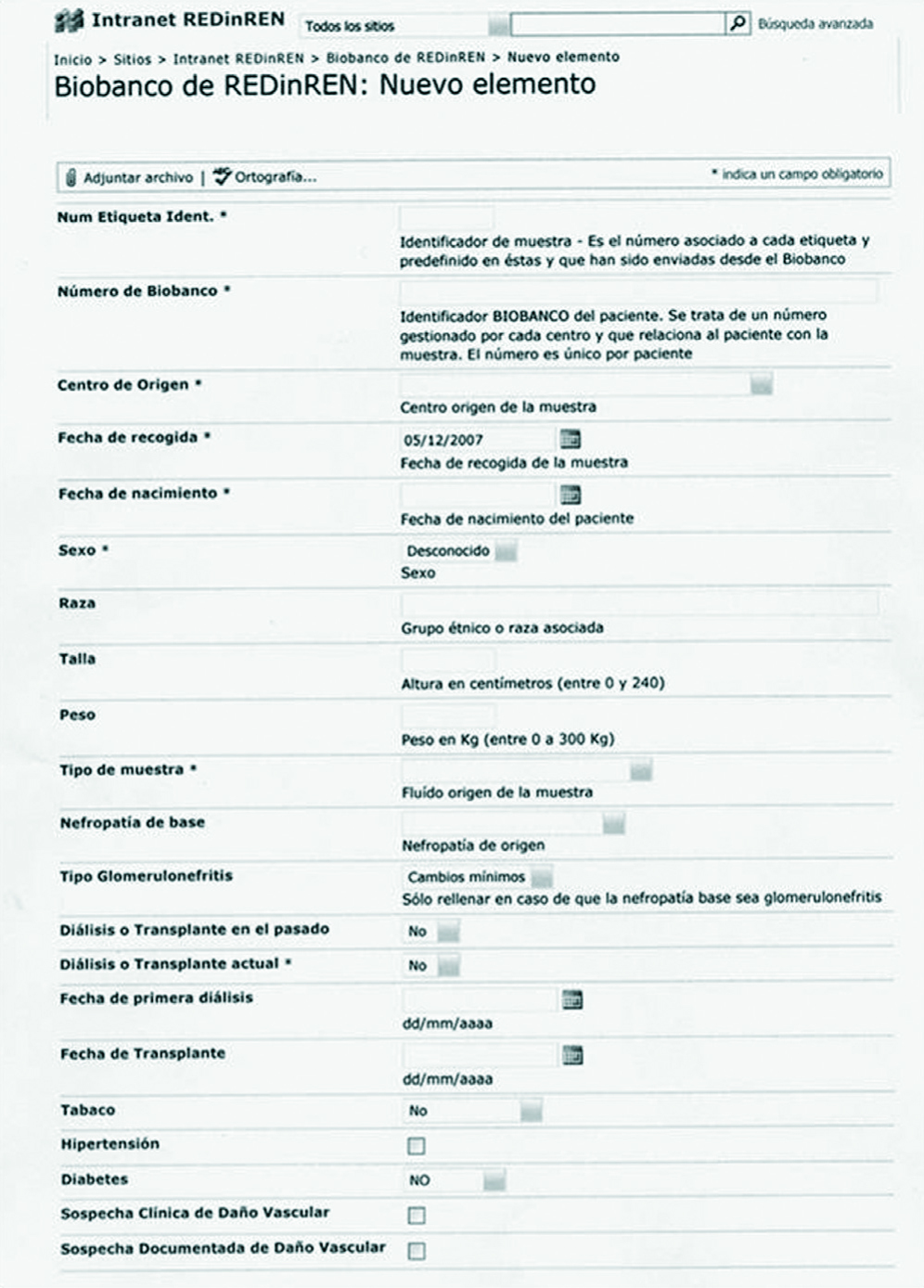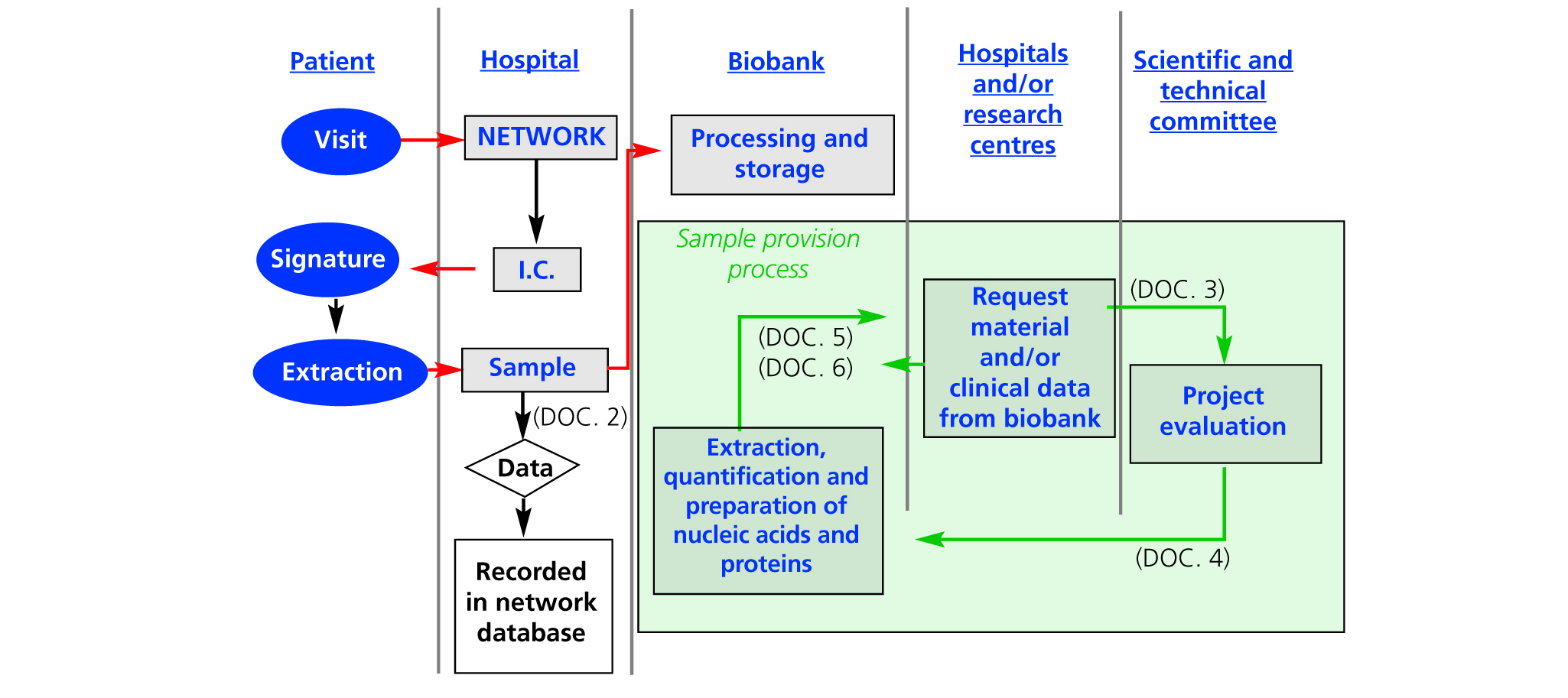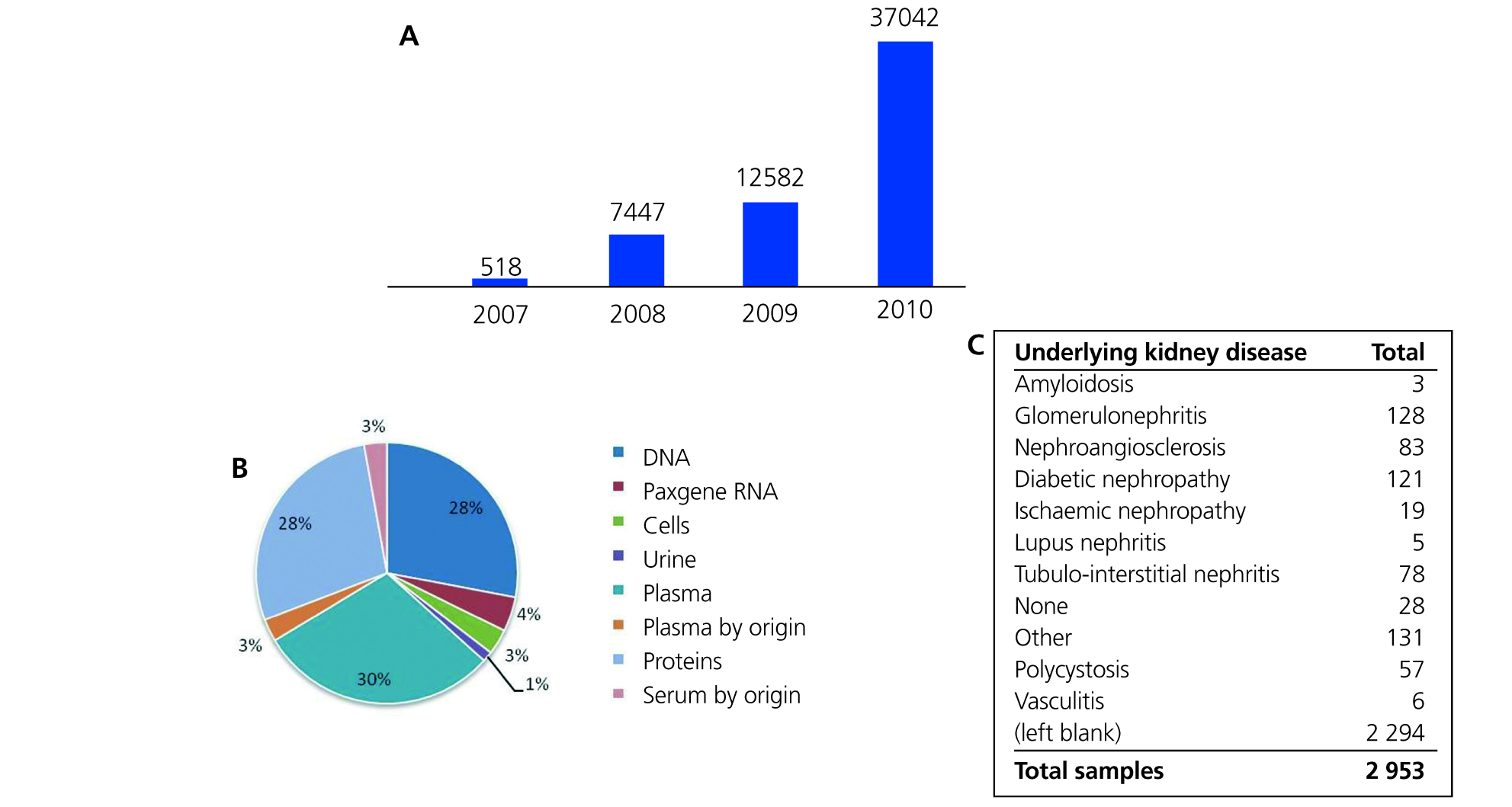Antecedentes: La creación del Biobanco, como una plataforma dentro de la Red de Investigación Renal (REDinREN), impulsa el avance de la investigación clínica de la enfermedad renal en España. Los objetivos del Biobanco son la generación del archivo de muestras clínicas y de datos asociados, para su cesión a los grupos de investigación, y la coordinación con biobancos europeos. Métodos: Para su puesta en marcha, fue necesaria la implementación de la normativa vigente (Ley de Investigación Biomédica y de Protección de Datos y la Normativa del Transporte de Sustancias Biológicas), un estricto protocolo de trabajo y la creación de una base de datos clínicos de la Red. Resultados: En su evolución, el Biobanco ha adquirido infraestructura y personal cualificado, lo que permitió que en el año 2010 se obtuviera un total de 2.953 pacientes, lo que hace un total de 37.043 viales almacenados con muestras de diferentes naturalezas. Además, hasta la fecha, el Biobanco está incluido en 11 proyectos de investigación. Discusión: Aunque el Biobanco fue diseñado como una plataforma de soporte de la REDinREN, es necesario con una acción conjunta poner a disposición de toda la comunidad científica nefrológica las posibilidades que otorga este sistema de almacenamiento de muestras biológicas para potenciar la investigación de la enfermedad renal.
Background: The creation of the Biobank, a resource pertaining to the Spanish Renal Research Network (REDinREN) promotes advances in clinical research on kidney disease in Spain. The Biobank’s aims are to generate an archive of clinical samples and associated data, furnish those samples to research teams, and coordinate with European biobanks. Method: Applicable legislation had to be complied with in order to launch the Biobank project (Biomedical Research Law, Data Protection Law and Biological Sample Transport Regulations). A strict work protocol and a new database for the Network’s clinical data were also implemented. Results: Over time, the Biobank has acquired additional infrastructure and qualified personnel. In 2010, 2953 new patient samples were collected, giving a total of 37 043 stored vials containing different types of samples. Furthermore, the Biobank is currently participating in eleven research projects. Discussion: Although the Biobank was originally designed for REDinREN use, we must take joint action to make this biological sample storage system and the many possibilities it offers available to the entire nephrological community with a view to promoting kidney disease research.
INTRODUCTION
The Biobank of the REDinREN (Spanish Renal Research Network) is a public, non-profit entity that stores a collection of samples intended for use in biomedical research into kidney disease. Its purpose is to contribute to advancing scientific knowledge of nephrological diseases as one of the activities coordinated by REDinREN, which is dependent on the Carlos III Institute of Health (RD6/0016/0002). This network is made up of groups of researchers from different regions in Spain. It enables researchers to undertake interdisciplinary, multi-centre research projects in strategic areas that focus on gaining a better understanding of kidney disease, with an emphasis on providing solutions for real, current problems in the field of nephrology. The Biobank is currently an essential platform for undertaking joint research activities in REDinREN. The Biobank’s initial list of objectives is found in Table 1, and all of its objectives are still in force. The Biobank is therefore a cross-sectional resource that provides support to nephrological research, and it may be considered as a complement to other biobanks that were created in the frameworks of a range of institutional initiatives.
METHOD
Aspects fundamental to the creation of the REDinREN Biobank
The REDinREN Biobank’s organizational structure and workings are based on four basic pillars: compliance with legislation, dedicated staff members, the development of standardised technical procedures, and a formal system to record and access clinical data. Each of these components is listed below.
1) Legal requirements: The REDinREN Biobank was designed according to the regulations stated in the Spanish Law for Biomedical Research (Law 14/2007 of 3 July).1 This Law states that patients must be informed by their doctors and give written consent before any samples may be sent to the Biobank. As a result, in one of the first steps toward creating the Biobank, the Ethics Committees at each hospital belonging to the network approved the Informed Consent forms that are provided to patients. Information is given in writing, and it covers the details, significance, implications and risks of donating samples to the Biobank, and mentions the donor’s right to revoke consent at any time. To obtain the samples, the Biobank depends on the free will of people who may choose to donate their biological samples to science. The Biobank reserves the right to audit the samples that are sent in to ensure that consent was properly given.
On a parallel note, the clinical database containing coded data pertaining to patients whose samples are stored in the Biobank has been registered with both the Spanish Data Protection Agency and the Madrid Data Protection Agency. The Biobank complies with the security requirements set forth by the Spanish regulation on security measures for computer files containing personal data, approved by Royal Decree 994/1999 of 11 June, in fulfilment of Organic Law 15/1999 of 13 December on Personal Data Protection.2
Lastly, all technical procedures described below were designed in accordance with the legally established requirements. All biological samples are stored in such a way that long-term preservation, quantity, and quality are assured, so that they can be used for current research projects and any future projects that may be undertaken as our knowledge of kidney disease and biotechnology increases.
2) Dedicated staff and associated Committee: The Biobank’s organisational structure is shown in Figure 1. During an early step in the process, the Biobank also trained specific personnel from each centre that would be sending samples. This was done so that the process would be standardised according to the protocols established for the entire network. The Biobank continues to train researchers and support staff that are new to the Network and will be providing samples.
3) Technical procedures: In order to guarantee quality sample processing and storage, the Biobank has established a Standard Working Procedure based on a quality management system similar to UNE-EN-ISO 9001:2008. Figure 2 shows a sample processing diagram. The Biobank receives blood and urine samples. At times, depending on the active lines of research, it also receives tissue samples. These samples are sent to the Biobank by courier. Taken from whole blood samples, it routinely stores plasma aliquots and cell samples from which DNA and proteins can be extracted. If there are enough cells with good viability (more than 80%), some of them are cryopreserved. By using the Qiagen automated system, RNA is isolated from blood that was extracted with PAXgene® tubes. Vials are stored in such a way as to guarantee that all aliquots can be found in the Biobank’s locator database.
For purposes of storing samples, the Biobank has storage systems set to −80 ºC and −180 ºC. Storage units are protected by a three-fold safety system: uninterruptible power supply (UPS), temperature sensors with remote alarm monitoring, and a connection to the Faculty of Medicine’s generator set. In this way, biological samples are guaranteed to be completely protected in the event of an electrical or computer system failure.
4) Quality of the clinical data record system and linking data correctly with stored samples: While the biological sample collection was being created, the Biobank also made a clinical database for the Network. It covers all of the patients with samples stored in the Biobank and contains all information needed in order to make full use of the biological samples. Although the initial design allowed for a single document (Figure 3), supplementary documents may be included in the different specific studies.
Patients selected to send samples to the Biobank are assigned a Biobank Number which allows entering their clinical data in the database. Patients’ personal data are not linked to clinical data, and they are not included in the same database. This archive is found online within the intranet of the Network’s webpage (www.redinren.eu). Members can gain access by using their personal passwords. Each hospital's access is limited to the clinical data of its own patients, and the hospital providing the data is the only one to know the patient's name and clinical history number. Every time a sample is extracted from a patient, it is given a Label Number and sent to the Biobank. Upon reaching the Biobank, the samples are coded (the samples are disassociated from identified donors, or made unidentifiable by using a code to substitute or disassociate the donor's identifying information. The code is also used to recover that information. The clinical database on the Network’s webpage records the Biobank Number and Label Number. The link between the sample and the patient is maintained in order to have the possibility of contacting the patient to obtain samples representing different moments in the progression of his or her kidney disease. In cases in which more than one sample will be extracted from the same patient, there will be multiple Label Numbers corresponding to the same Biobank Number (the opposite cannot occur.) The researcher who gains access to the sample receives only the Label Number, and never the Biobank Number. This provides additional protection for patient confidentiality throughout the entire procedure and complies with current security regulations.1-2
5) Sending and requesting samples: Meanwhile, the Biobank has finished designing both its webpage and its intranet area. Here, all Network members enjoy a range of computerised mechanisms for accessing Biobank information: forms for sending or requesting samples, the calendar to reserve a dispatch date, and a summary of the Biobank’s inventory available to research teams.
Collecting, transporting, handling and dispatch of samples all take place under biosecure conditions that comply with applicable legislation (WHO regulations on the Transport of Infectious Substances).3 The Biobank guarantees the following in sample transport: sample identification and traceability, a definition of the preparation conditions, handling and transport conditions required by each type of sample, and proper training for the personnel handling and preparing the samples. When transporting samples abroad, the Biobank will transmit all of the required documents in accordance with Spanish Royal Decree 65/20064 for exporting biological samples and sending them through customs checkpoints.
In addition, the Biobank's Scientific and Technical Committee has drawn up and approved the documents needed by researchers in order to donate and/or provide Biobank samples (Figure 4). Requests for samples and/or data will be evaluated by the Biobank Scientific and Technical Committee; a Clinical Research Ethics Committee must necessarily support the study in question. Biological samples stored in the Biobank may be used in research projects undertaken by REDinREN members. If permission is granted by the Scientific and Technical Committee, they may be used in research projects with third-parties, provided that a REDinREN member is participating in the project. The provision of a sample can be accompanied by the associated clinical information from the Network’s clinical database, with the necessary guarantees for personal data protection. If provision of the sample is approved following the evaluation, a cession agreement is signed. This agreement stipulates the regulations for collecting samples, the samples for which access is provided, the lead researcher and the project in which the samples will be used, the researcher's obligations (use for exclusive purposes of the approved project; not to store, return, or transfer it to a third party; and to use the minimum quantity possible), the possibility of Biobank running an audit to verify that contractual conditions have been met, and the requirement of including Biobank’s name in publications (material and methods). Lastly, upon completion the project, researchers are required to report their final results.
RESULTS
Evolution and description of the current state of the Biobank
1) Infrastructures: The REDinREN Biobank is located within the Faculty of Medicine of the University of Alcalá (Madrid). Launching the biobank involved facility remodelling, purchase of a complete set of equipment and start-up of the entire laboratory. From the time it was created to the present, the REDinREN Biobank infrastructure has grown considerably. Since its inception, it has added 2 new –80 ºC vertical laboratory freezers to bring its total to 3, as well as the corresponding temperature probes, a higher-powered UPS system and 3 times as much physical capacity as was found in the original laboratory.
2) Personnel: The substantial increase in the workload arising from the greater number of samples and requests for material for a variety of projects has resulted in the need for more supporting technicians. These tasks were originally carried out by 1 person, but we currently have 4 staff members dedicated to the different phases of sample processing. Maintaining qualified personnel is a continuous training task that is essential to make the Biobank work properly.
3) Stored samples and recorded patients: The dispatch, collection, processing and storage system is currently working correctly; having received biological samples from all hospitals within the Network. As shown in Figure 5A, the Biobank stored 518 vials in 2007; this number has increased considerably, reaching 37 042 in 2010. Of the total of vials that are categorised by type (Figure 5B), we have plasma vials (30%), vials for DNA isolation (28%), and vials for protein extraction (28%). We must consider that urine vials (1%) are only collected in specific cases and that as RNA extraction with the PAXgene® system is very expensive, it is only performed in a few selected patients (4%). Meanwhile, through Biobank’s collaborative efforts with the Nefrona project, new samples were added to the Biobank at the end of 2010. These include plasma and serum samples that are separated at the hospital of origin and arrive at the Biobank ready to be stored. This guarantees the preservation of a number of biomarkers that may change in the transport of whole blood samples.
Lastly, based on data entered by researchers on the Website, we have a list of all pathologies for which samples are kept in the Biobank (Figure 5C). Those in white were gathered by the Nefrona project.
Research projects linked to the Biobank
1) General strategy: prospective inclusion of patients meeting the following criteria: although patient inclusion criteria were originally very general, samples are currently being taken from patients with specific characteristics that are matched to each project.
2) Specific strategies: the Biobank as a resource for specific research projects. The Biobank is currently involved in several collaborative scientific projects with Network members. Collaborative projects in the framework of the Spanish National Plan: 6 projects; Collaborative projects with a European Network: 1; research projects receiving private funding: 3; clinical trials: 1. The Biobank has also applied to be included in a European Biobank Network for dialysis patients (ERA-EDTA. EURECA-m BIOBANK).
DISCUSSION
Future prospects
Our Biobank was designed to strictly comply with all applicable legislation. This will grant us access to the National Biobank Register as soon as it is created, as provided for by Law 14/2007, and the relevant Royal Decree has been issued. The register will aid us in publicising our Biobank on a national level and foster access to biological material by the scientific community.
Furthermore, all of our procedures are managed with a view to obtaining top quality, and we are now beginning to launch our quality management programme so as to be certified by AENOR under ISO standard 9001:2008 in the near future.
Although the Biobank was initially designed as a support platform for the REDinREN, the aim of the Network members and Biobank administrators is to place all of the possibilities contained in this biological sample storage system at the disposal of the nephrological research community.
Lastly, integrating our Biobank in a European network of biobanks with kidney patient samples may be a key step towards facilitating the export of samples to other countries This would promote collaborative efforts in international research projects.
ECONOMIC CONSIDERATIONS IN CREATING THE BIOBANK
Most of REDinREN’s Biobank infrastructures and personnel are financed by the Biobank’s parent entity Carlos III Health Institute (REDinREN, Spanish Renal Research Network from the Carlos III Institute of Health, FEDER funds, RD6/0016/0002). With the permission of this institution, the Biobank has applied for specific grants from private organisations or projects. These include FRIAT (Íñigo Álvarez Renal Foundation of Toledo) and the Nefrona project which is supported by the S.E.N. (Spanish Society of Nephrology) and by Abbott Laboratories. On the other hand, the cost of processing the samples requested for a specific project, whether public or private, is borne by the project itself.
ACKNOWLEDGEMENTS
- Carlos III Health Institute: (REDinREN, Spanish Renal Research Network from the Carlos III Institute of Health, FEDER funds, RD6/0016/0002).
- FRIAT (Íñigo Álvarez Renal Foundation of Toledo).
- Reina Sofía Institute of Renal Research (IRSIN).
- Nefrona project, supported by the S.E.N. and Abbott laboratories.
Table 1. Biobank objectives
Figure 1. Biobank organisational structure
Figure 2. Biobank action protocol
Figure 3. Clinical data sheet for the REDinREN biobank
Figure 4. Summary of the main steps for donating and gaining access to biobank samples
Figure 5. REDinREN Biobank inventory


